Here’s the truth:
Earning quality links through traditional methods takes plenty of time and effort.
Trust me, I know this firsthand.
That's exactly why blogger outreach services have become a go-to resource for SEO agencies, in-house marketers, and business owners looking to scale up their link-building without getting buried in manual prospecting, cold emails, or negotiations.
But with dozens of providers out there, how do you know which ones deliver quality links — and which are just scamming you out of your hard-earned cash?
To make things easier, I've done the hard work for you.
In this guide, I'll break down four of the most respected blogger outreach services in the industry:
- Editorial.Link
- BibiBuzz
- Pearl Lemon
- Click Intelligence
I'll also share exactly why I picked these companies, their strengths, processes, and pricing. So you can make the best choice for your SEO goals.
How I Chose These Blogger Outreach Services
So, how did I narrow down the vast sea of blogger outreach services to the four you're about to see?
I used a blend of criteria that matter most to real SEO professionals.
First, I looked at the overall reputation and brand recognition. Because let's face it, trust counts big time in our world.
I also leaned heavily on third-party ratings from trusted sites like Clutch and Trustpilot.
Pricing structure and transparency played a crucial role, too. Nobody likes paying through the nose or getting surprised by hidden fees.
And of course, I dug into case studies to see if these services actually deliver measurable SEO results.
Finally, I factored in transparency, client feedback, and whether or not they offered a clear outreach methodology.
Best Blogger Outreach Services
Without further ado, let’s start with the list of the best blogger outreach services.
1. Editorial.Link
Editorial.Link is a blogger outreach service founded in 2020 by Dmytro Sokhach.
Yes, that’s me.
My vision was clear from day one: securing genuine, editorial backlinks — no sketchy PBNs or spammy link farms.
Every website we work with is thoroughly vetted, checking domain authority, clean outbound profiles, and ensuring real, consistent traffic (at least 5K visits/month).
We've partnered with global companies, like NordVPN, PandaDoc, and DiscoverCars, and SEO agencies, including Hennessy Digital, to help them achieve real results.

Here’s why our clients keep coming back:
✅ Quality-first approach: Real editorial links from authentic, high-authority sites. Average DR? 67.
✅ Full client control: Every single outreach target is pre-approved by you.
✅ Risk-free pricing: No upfront fees — you only pay after your links are live.
✅ Crystal-clear reporting: Transparent, proactive communication every step of the way.
✅ 6-month warranty: We replace lost links promptly, at no extra cost.
Our outreach process is straightforward and hands-on:
- Research: Deep dive into your niche, content, and SEO goals.
- Finding placements: Identifying relevant high-authority blogs.
- Approval: You review and approve every proposed placement.
- Personalized outreach: Manual, relationship-driven email outreach.
- Link placement: Content is published, and your backlink goes live.
- Reporting: We deliver detailed, transparent reports (including white-label ones for SEO and marketing agencies).
Our pricing starts at $375 per link and goes down to $350 if you order 5 links ($1,750 for package).
We also offer premium backlinks at $550 each.
High-authority, high-impact placements for the pages that need an extra boost.
Curious what our clients say?
Check out our Clutch (5.0/5) and Trustpilot (4.1/5) reviews!
2. BibiBuzz
BibiBuzz is a boutique blogger outreach service founded by Bibi Raven — a name many SEOs recognize and trust.
Her service is a fully managed, manual approach to link building, entirely free from databases or automation. Every website she selects goes through rigorous vetting for real organic traffic, clean outbound link profiles, and high relevance.
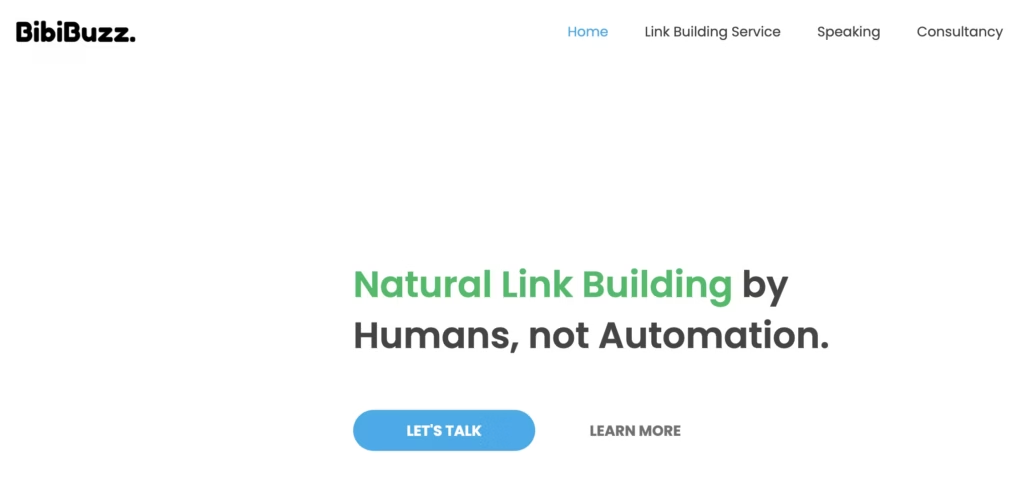
Here’s what stood out to me about BibiBuzz:
✅ Fully customized outreach: Every pitch is uniquely crafted. No generic email blasts here.
✅ Editorial excellence: Links are contextually placed within genuinely high-quality, niche-relevant content.
✅ Personalized Service: With Bibi personally managing each campaign, communication is consistently transparent and responsive.
BibiBuzz’s process is refreshingly clear:
- Discovery & strategy: In-depth analysis of your niche, audience, and goals.
- Competitor & content analysis: Identifying relevant content ideas.
- Prospect list creation: Manual selection of relevant, quality sites (around 200 prospects to start with).
- Personalized outreach: Tailored outreach emails sent in batches and tracked for performance.
- Content & link placement: Contextually relevant backlinks get placed within carefully crafted content.
Bibi’s pricing starts at $6,000 for a package of 10 backlinks (around $600 per link). All backlinks are dofollow, placed on genuinely authoritative blogs.
3. Pearl Lemon
Pearl Lemon is a UK-based SEO agency founded in 2017, offering blogger outreach both as a standalone service and as part of their wider SEO packages.
Their outreach process is manual and meticulous. It involves tailored prospecting, personalized email pitches, and in-house content creation — zero reliance on link farms or paid guest post directories.
Pearl Lemon focuses on securing placements on blogs with genuine traffic and strong domain authority metrics, so every link is placed contextually within highly relevant content.

Here’s what I appreciate about Pearl Lemon:
✅ High-quality prospecting: They only target authoritative blogs with genuine, verifiable traffic.
✅ Full transparency: Detailed reporting with URLs, anchor texts, and metrics included.
✅ Wide industry reach: Proven track record across B2B, SaaS, eCommerce, and more.
✅ White-label friendly: Ideal for agencies looking to scale outreach without compromising on quality.
The Pearl Lemon process is based around:
- Manual prospecting: Identifying high-quality blogs tailored to your niche.
- Personalized outreach: Custom emails that resonate with blog editors.
- Content creation: In-house team crafts content specifically for each placement.
- Link placement: Backlinks are contextually embedded within published content.
- Detailed reporting: Transparent and timely reports delivered directly to you.
Pearl Lemon's pricing typically requires custom quotes based on your needs, but their Clutch profile suggests packages often start around $3,780/month for comprehensive services.
What else do their clients say? Check their Clutch (4.8/5) and Trustpilot (4.5/5) reviews.
4. Click Intelligence
Click Intelligence is a UK-based digital marketing agency, founded in 2013, that positions blogger outreach as a central component of its robust link-building strategy.
The Click Intelligence team manually selects blogs based on real organic traffic and strong domain metrics, steering clear of low-quality sites or paid guest-post directories.
They manage outreach and content creation entirely in-house for greater consistency and control.
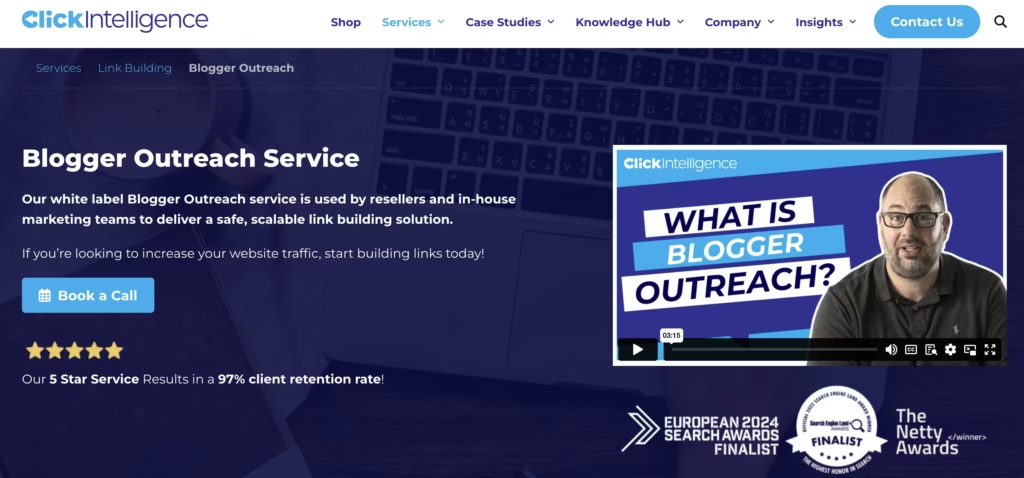
Here’s why Click Intelligence caught my attention:
✅ Handpicked quality: Sites are chosen based on strict DA requirements and genuine organic traffic.
✅ Dofollow links only: Every link placed is dofollow for maximum SEO value.
✅ Transparent reporting: Detailed reports covering live URLs, anchor texts, and key performance metrics.
✅ Agency-friendly: They offer white-label solutions. Perfect if you're scaling up client link-building services.
Their step-by-step process includes:
- Your SEO goal analysis: Assessment of your objectives for a tailored SEO strategy.
- Industry and competitor research: A dive into your niche and competitor backlink profiles to identify opportunities.
- Blog prospecting: Manual identification of authoritative, niche-relevant sites.
- Personalized manual outreach: Direct, tailored contact with blog editors and owners.
- Content production: Original, in-house written content designed specifically for each placement.
- Link placement: High-quality, contextually relevant backlinks.
Click Intelligence offers flexible pricing based on domain metrics and specific industry needs, starting at $76 per link for DR20+ placements if you order 50+ backlinks, and scaling upward to $414 for a DR60+ link.
Want to know more about their work? Have a look at their Clutch (5.0/5) and Reviews.co.uk (4.9/5) profiles.
Blogger Outreach FAQ
Nearly there! Let’s wrap up with a few answers to commonly asked questions about blogger outreach.
What is blogger outreach?
Blogger outreach is a digital marketing strategy focused on building relationships with bloggers and influential content creators.
The idea is simple: find bloggers relevant to your niche, connect, and collaborate on valuable content, like guest posts, product reviews, or sponsored articles.
Done right, blogger outreach is a win-win. You earn powerful backlinks and exposure to a targeted audience, while the blogger gains high-quality content and fresh ideas for their readers.
Effective outreach involves highly personalized communication and mutual value exchange, so you gain genuine endorsements and visibility rather than spammy mentions.
What are the benefits of blogger outreach?
Here’s why blogger outreach should be on your radar:
- Better SEO: High-quality backlinks from authoritative sites boost your rankings and domain authority. Google sees these genuine editorial links as strong credibility signals.
- Higher AI Search Visibility: AI tools like ChatGPT and Gemini pull information from trustworthy sources, so getting your brand featured in niche blogs increases the chances of getting cited in their answers.
- Targeted traffic: Getting mentioned by influential bloggers drives highly relevant, organic traffic directly to your site.
- Improved brand credibility: Being featured by respected bloggers acts as powerful social proof and immediately boosts your brand’s authority.
- Greater social reach: Collaborations often spill over to social media and amplify your brand’s visibility and engagement across platforms.
- Long-term relationships: Strong blogger relationships open doors to continual coverage, ongoing referrals, and valuable industry connections.
At Editorial.Link, for instance, we secured a feature on Search Engine Land purely by sharing unique insights from our State of Link-Building Report, without paying a penny. That single article drove massive exposure.
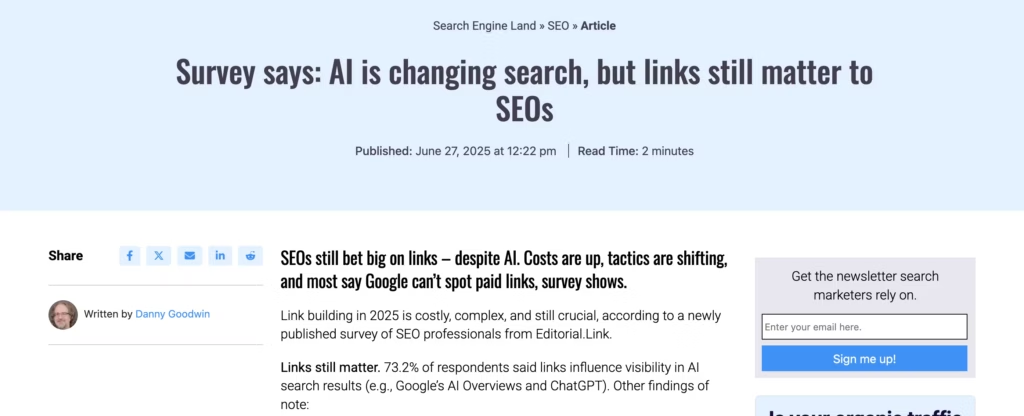
How to do blogger outreach by yourself?
Here's how you can effectively manage blogger outreach internally:
- Define clear goals: Know exactly what you want — whether it’s domain authority, brand awareness, or referral traffic boost.
- Research bloggers: Identify influencers and blogs in your niche using tools like BuzzSumo. Create a database with their contact info, domain authority, and audience engagement.
- Vet and prioritize: Evaluate the bloggers carefully. Prioritize those whose audience and content best align with your brand’s goals.
- Build relationships first: Engage informally before sending your pitch. Comment on their posts, share their content, or interact on social media to build familiarity.
- Craft personalized emails: Send concise, friendly, and genuinely helpful emails. Clearly articulate the mutual benefit and explain why your audience will appreciate your content.
- Strategic follow-ups: Send polite reminders if there’s no reply after a few days. Stats show one follow-up can significantly improve response rates.
- Track and refine: Maintain detailed records of your outreach efforts. Analyze what works, refine your pitches, and continually improve your approach.
How to find blogger outreach opportunities?
Finding the right bloggers is key. Here's a quick way to uncover valuable outreach opportunities:
Google search operators
Use queries like "your niche + guest post", "your niche + write for us", or "your niche + inurl:guest-post" to find blogs actively accepting contributions.
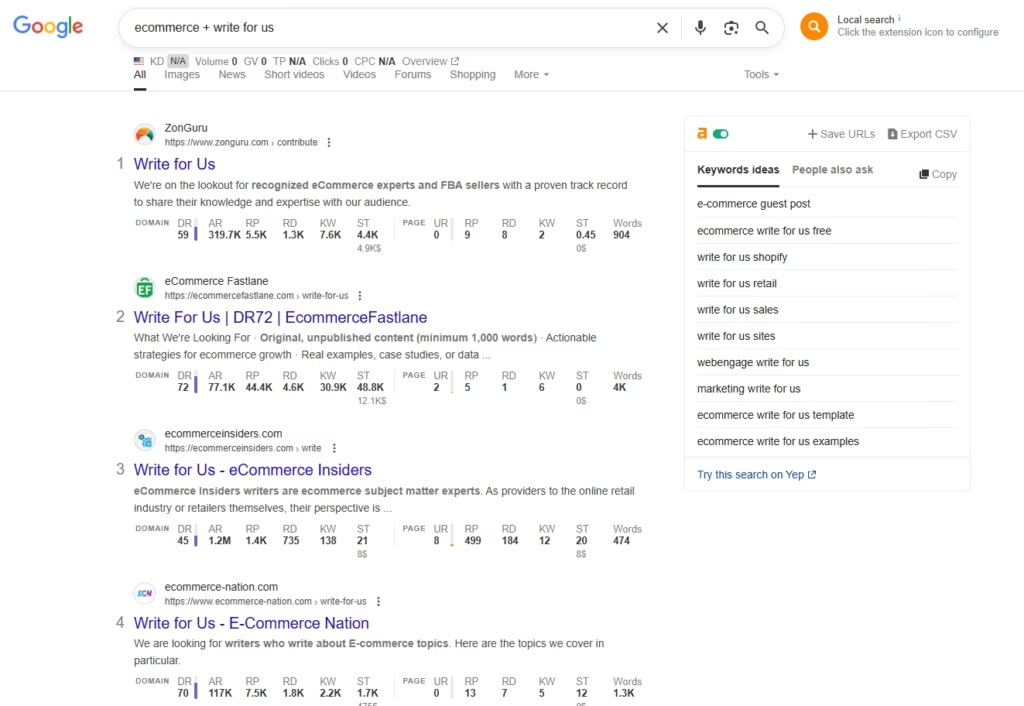
SEO tools
Tools like Ahrefs or Semrush let you discover influential blogs, assess their domain authority, and analyze competitors’ backlink profiles to spot hidden opportunities.
For example, we use Ahrefs to identify competitor brand mentions.
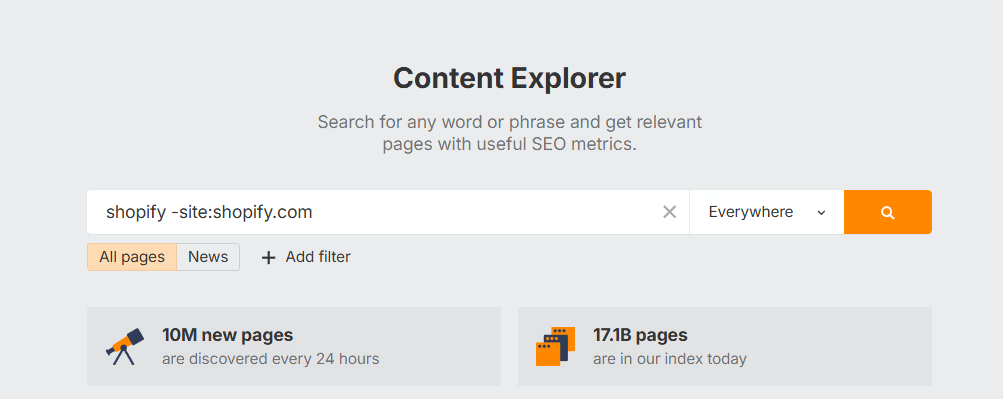
Influencer discovery tools
Platforms like BuzzSumo, Roxhill, or Pitchbx help quickly identify and filter bloggers based on their engagement, influence, and niche relevance.
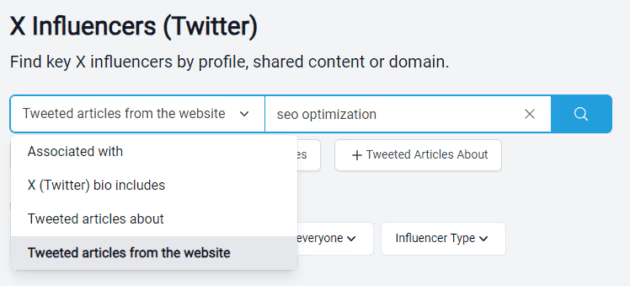
Social media & communities
Search relevant hashtags and industry-specific groups on Twitter, LinkedIn, Facebook, and Reddit to identify active content creators in your space.
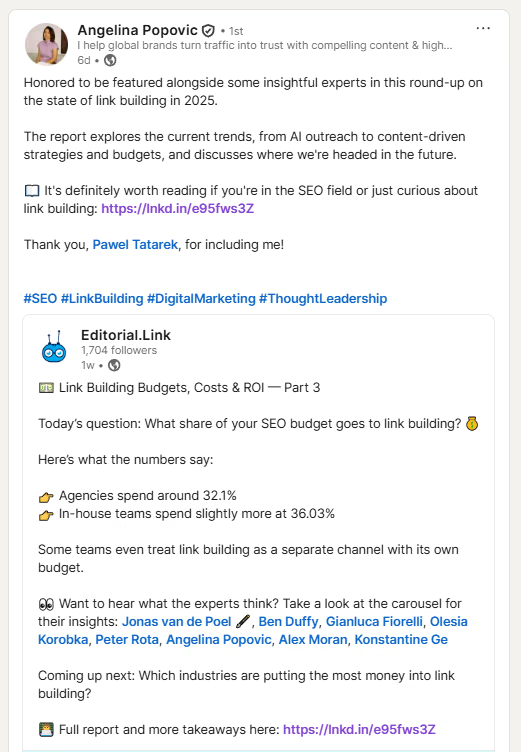
Resource pages & roundups
Look for resource pages or weekly round-up posts within your niche. These can provide a ready-made list of engaged bloggers who actively share quality content.
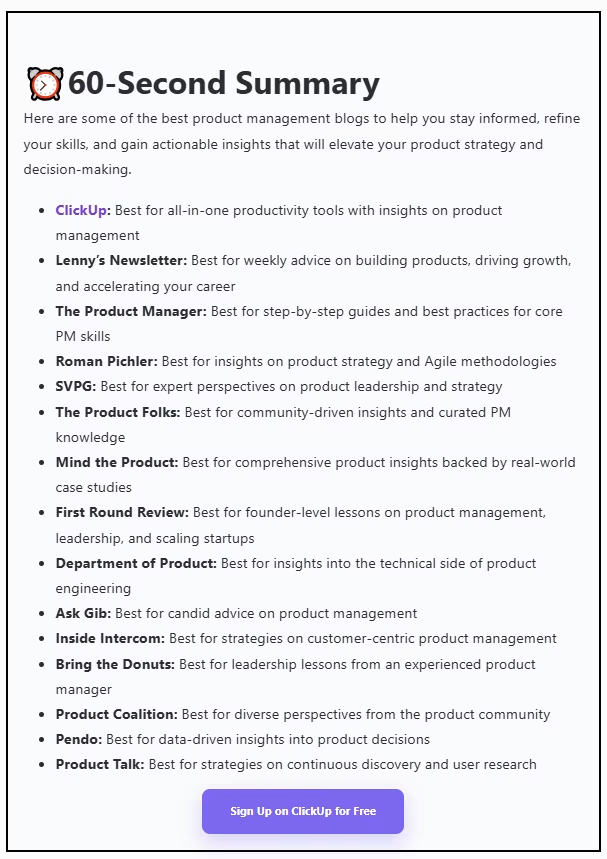
AI search
Use ChatGPT, Perplexity, and AI Overviews to find blogs they use as sources.
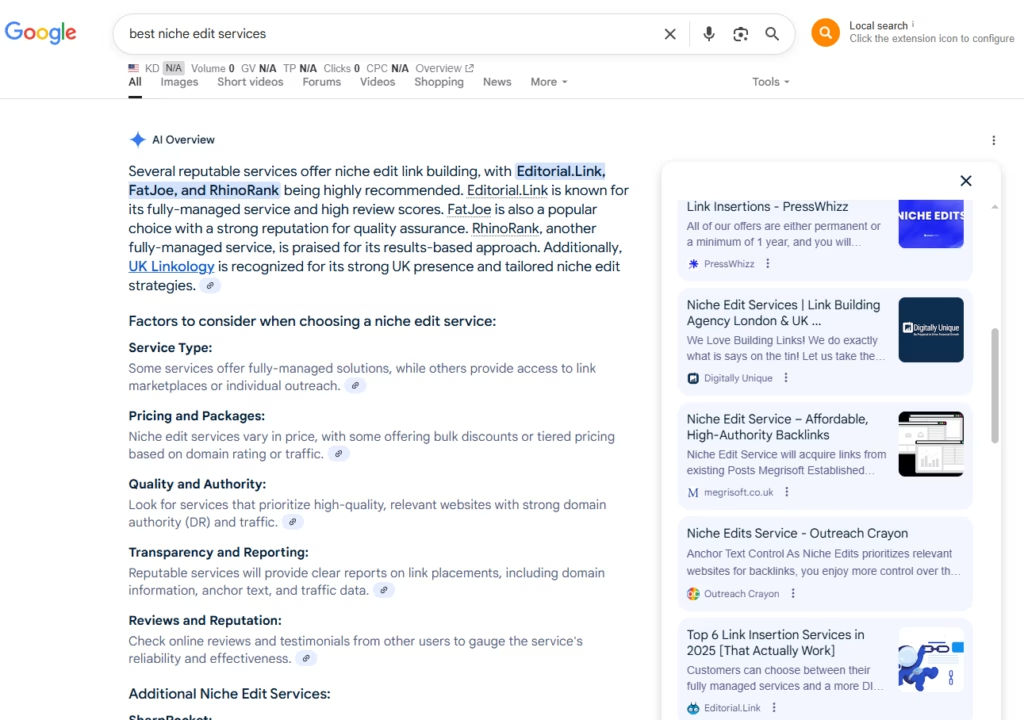
What are blogger outreach best practices?
Want to nail your outreach? Stick to these best practices:
- Choose relevance over numbers: Focus on bloggers whose audience aligns closely with your brand. Quality beats quantity every time.
- Personalization is the secret sauce: Generic emails rarely get results. Personalize each pitch with specific references to their content and interests.
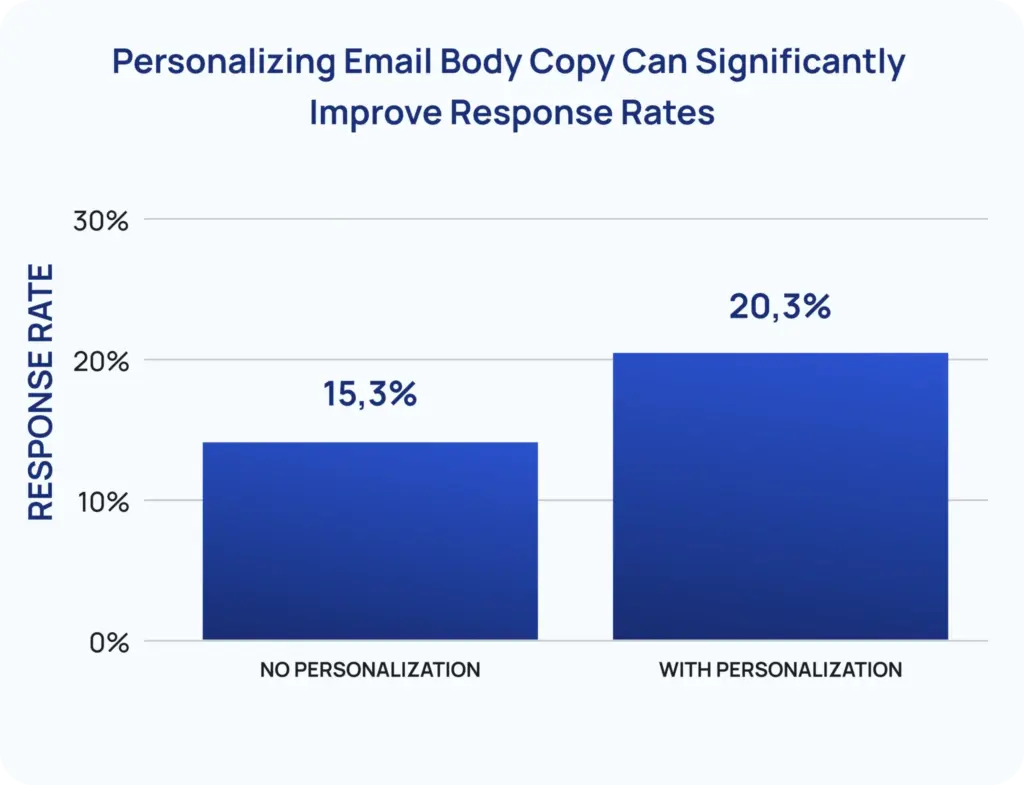
- Offer genuine value: Clearly articulate what's in it for the blogger. Whether it's unique content, exclusive insights, or free credits, always lead with value.
- Keep it concise: Bloggers are busy—keep your pitches short, clear, and direct. A concise email (under 150 words) with a strong, personalized subject line boosts open and response rates.
- Follow up respectfully: A polite reminder email can drastically improve response rates. But don’t overdo it! 1–2 follow-ups, sent 3-4 days apart, are enough. Or you end up in their spam folder.
- Focus on long-term relationships: Don’t just seek one-off mentions. Cultivate ongoing, genuine relationships that bring repeated coverage and mutual value.
- High-quality content only: Ensure whatever you pitch (guest post, infographic, product) is truly valuable. Bloggers protect their audience’s trust fiercely.
Ultimately, successful outreach is about genuine human connections. Prioritize authenticity, respect, and mutual benefit, and you'll build relationships that continually support your brand’s growth.
Final Thoughts
Choosing the right blogger outreach service can genuinely transform your link-building results, freeing you from the endless cycle of prospecting, emailing, and negotiation.
Whether you opt for the meticulous approach of Editorial.Link, the personalized charm of BibiBuzz, the wide industry reach of Pearl Lemon, or the flexible, scalable solutions from Click Intelligence — each of these services offers something unique, proven, and effective.
If you want to scale your blogger outreach with Editorial.Link, book a free strategy call, and let’s discuss how we can help you achieve your SEO goals.

